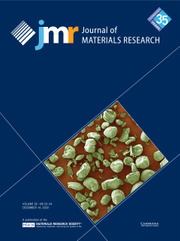Crossref Citations
This article has been cited by the following publications. This list is generated based on data provided by
Crossref.
Kim, M.J.
Chen, Y.L.
Carpenter, R.W.
Barry, J.C.
and
Schwuttke, G.H.
1990.
Σ =13 tilt grain boundary in silicon bicrystal.
Proceedings, annual meeting, Electron Microscopy Society of America,
Vol. 48,
Issue. 4,
p.
562.
Murrell, M. P.
Sofield, C. J.
and
Sugden, S.
1991.
Silicon transport during oxidation.
Philosophical Magazine B,
Vol. 63,
Issue. 6,
p.
1277.
Kim, M. J.
and
Carpenter, R. W.
1991.
High Resolution Analysis of Structure and Chemistry of Grain Boundaries in Silicon.
MRS Proceedings,
Vol. 238,
Issue. ,
Al-Bayati, Amir H.
Orrman-Rossiter, Kevin G.
and
Armour, D.G.
1991.
Study of residual damage in Si(001) due to low energy (110 eV) Ar+ and Cl+ bombardment using medium energy ion scattering.
Surface Science,
Vol. 249,
Issue. 1-3,
p.
293.
Catalano, M.
Kim, M.J.
Carpenter, R.W.
and
Wong, J.
1991.
Nanoanalysis of semi-insulating polycrystalline silicon by high-spatial-resolution electron microscopy.
Proceedings, annual meeting, Electron Microscopy Society of America,
Vol. 49,
Issue. ,
p.
738.
Al-Bayati, Amir H.
Orrman-Rossiter, Kevin G.
van den Berg, J.A.
and
Armour, D.G.
1991.
Composition and structure of the native Si oxide by high depth resolution medium energy ion scatering.
Surface Science,
Vol. 241,
Issue. 1-2,
p.
91.
Benyaïch, F.
Priolo, F.
Rimini, E.
Spinella, C.
and
Ward, P.
1992.
Structural characterization of the epitaxial realignment of polycrystalline silicon films.
Materials Chemistry and Physics,
Vol. 32,
Issue. 1,
p.
99.
Sofield, C J
Murrell, M P
Sugden, S
Heyns, M
Verhaverbeke, S
Welland, M E
Golan, B
and
Barnes, J
1992.
Cleaning Procedures for UHV Cluster-tool MOS Fabrication.
MRS Proceedings,
Vol. 259,
Issue. ,
Kim, M.J.
Carpenter, R.W.
Chen, Y.L.
and
Schwuttke, G.H.
1992.
Structure and precipitation on a Σ = 13 tilt grain boundary in silicon.
Ultramicroscopy,
Vol. 40,
Issue. 3,
p.
258.
Cacciato, A.
Benyaïch, F.
Spinella, C.
Rimini, E.
Fallico, G.
and
Ward, P.
1993.
Structural and electrical study of epitaxially realigned Sb-doped polycrystalline Si films.
Materials Science and Engineering: B,
Vol. 18,
Issue. 3,
p.
289.
Catalano, M.
Kim, M.J.
Carpenter, R.W.
Chowdhury, Das K.
and
Wong, Joe
1993.
The composition and structure of SIPOS: A high spatial resolution electron microscopy study.
Journal of Materials Research,
Vol. 8,
Issue. 11,
p.
2893.
Bart, F.
Jollet, F.
Duraud, J. P.
and
Douillard, L.
1993.
Electronic Structure of α‐Quartz. A XANES Study of Empty States.
physica status solidi (b),
Vol. 176,
Issue. 1,
p.
163.
Waytena, G. L.
1993.
Electron microscopy and energy loss study of low temperature plasma deposited oxide on a CZ grown Si substrate.
Journal of Electronic Materials,
Vol. 22,
Issue. 1,
p.
93.
Cacciato, A
Benyaich, F
Spinella, C
Rimini, E
Romano, P
and
Ward, P
1993.
Electrical characterization of polycrystalline silicon films on Si substrates processed by rapid thermal annealing.
Semiconductor Science and Technology,
Vol. 8,
Issue. 3,
p.
327.
Huang, L. J.
Lau, W. M.
Tang, H. T.
Lennard, W. N.
Mitchell, I. V.
Schultz, P. J.
and
Kasrai, M.
1994.
Near-surface structure of low-energy-argon-bombarded Si(100).
Physical Review B,
Vol. 50,
Issue. 24,
p.
18453.
Bart, F.
Gautier, M.
Jollet, F.
and
Duraud, J.P.
1994.
Electronic structure of the (0001) and (101̄0) quartz surfaces and of their defects as observed by reflection electron energy loss spectroscopy (REELS).
Surface Science,
Vol. 306,
Issue. 3,
p.
342.
Chowdhury, K. Das
Carpenter, R. W
Braue, W.
Liu, J.
and
Ma, H.
1995.
Chemical and Structural Widths of Interfaces and Grain Boundaries in Silicon Nitride–Silicon Carbide Whisker Composites.
Journal of the American Ceramic Society,
Vol. 78,
Issue. 10,
p.
2579.
Huang, L.J.
Lau, W.M.
Mitchell, I.V.
Tang, H.T.
and
Lennard, W.N.
1995.
Characterization of Si(100) sputtered with low energy argon.
Nuclear Instruments and Methods in Physics Research Section B: Beam Interactions with Materials and Atoms,
Vol. 106,
Issue. 1-4,
p.
34.
Pan, J. S.
Wee, A. T. S.
Huan, C. H. A.
Tan, H. S.
and
Tan, K. L.
1996.
Argon incorporation and silicon carbide formation during low energy argon-ion bombardment of Si(100).
Journal of Applied Physics,
Vol. 79,
Issue. 6,
p.
2934.
Kumar, A.
and
Knowles, K.M.
1996.
Microstructure-property relationships of SiC fibre-reinforced magnesium aluminosilicates—I. Microstructural characterisation.
Acta Materialia,
Vol. 44,
Issue. 7,
p.
2901.

